Davis Hall: Actor-Costume Designer Colaboration
Author: Cheryl Kilbourne-Kimpton
This is the last in our FIT series and we are joined by actor/director Davis Hall. He talks to us about the other side of the collaboration between a Costume Designer and an actor, what helps an actor and what drives an actor crazy!

Ingrid: Our next guest is Davis, and you’ve seen his face before, you’ve seen him on Madam Secretary, and full disclosure, he’s also my husband!
So Davis, you’ve worked on stage and in film… are there tips or tricks that you’ve picked up over the years that you’d like to pass along to the next generation of designers?
Davis: Well, this is my favorite story and it really relates to a very specific situation. I was doing a stage production of a play set in the Shakespearean times, so I was wearing a doublet and tights. I was playing Guildenstern. It’s a big part in a long play. And the designer had made it so that I couldn’t take the costume off. I couldn’t go to the bathroom! Because the tights were on suspenders and the tunic was all laced up. So my first thing is: always make sure the actors can go to the bathroom! I finally worked something out by putting the suspenders on huge snaps, but I couldn’t ever really take it off!
Ingrid: Practicality helps! When I worked with an actor named Elizabeth Ashley, she told me that your footwear is where the rubber meets the road. That’s an exact quote. Davis, what do you think?
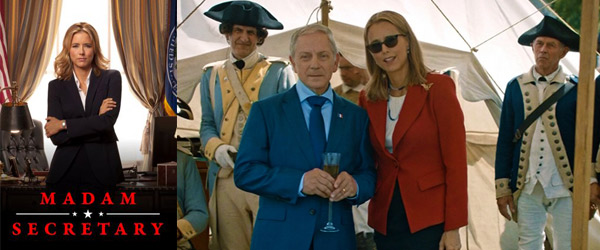
Madam Secretary
Davis: Often on camera, I bring my own. Unless I’ve got to be done up in a tuxedo with patent leather shoes and such, in which case there will be a fitting. My feet are wide but fairly standard size. I did a play where they made the boots for me, because they knew I’d be on my feet a lot. But for the most part when you’re doing on camera work with contemporary clothes, it’s good to have some of your own shoes that are comfortable. I had a pair of shoes that I thought were really cool and I wore them to set, but it turned out they squeaked like crazy and I couldn’t wear them without putting felt on the bottom.
Another stage play I did, I was in a restoration comedy playing the fop, a comic character. And the designer, who was quite well known in the business
Ingrid: A multiple Tony winner…
Davis: Yes… he designed a costume to make me funny. He based it on the idea of a rooster. Well, there’s nothing worse for an actor to have the costume be funnier than the actor. So I always say, “don’t do too much of my job. Just help me a little…”
On stage it’s very different than it is on camera. You go to the first meeting and you see what you’re going to look like. And sometimes you think, “Oh, that’s fantastic, that’s so great,” but other times it’s “oh, that is just so awful… but maybe I can sell it.” Or maybe the designer has seen something about my character that I haven’t seen, and we can put the two together. And occasionally I’ve seen a garment and that’s given me an idea and I’ve talked to the designer and said… “Maybe more buttons down the front that I can button up to give me some business” and they say “sure!” So that first day is either so great, like, “that’s gonna support what I’m doing and it’s even more than I saw, “ or sometimes you’re figuring out how you’ll make it work.
Ingrid: How spontaneous do you become in a costume fitting for a play? I know you, and the designer, probably the person who’s draping and cutting the costume if it’s being built, you’re all there staring at the character in the mirror, and do things suddenly occur to you? Like EYEGLASSES! Or a CANE!
Davis: Usually we’re starting out with a muslin and I know what business I have to do…
Ingrid: Does everyone know what a muslin is?
Davis: The costume is cut out of muslin fabric first and you try it on for the fitting and they’ll use that as a pattern. So I’ll go through the moves that I have to do onstage to make sure nothing is going to rip. And I’ve done some plays that involved stunts.
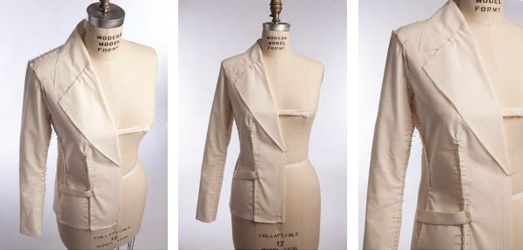
Muslin Pattern Making
I did a play called “The Mystery of Irma Vep” that was all about quick changes and that was literally where I’d exit the stage as a male character, run around and enter as a female character with a full dress. And the other actor who was doing it with me was doing the same thing. And we were constantly in motion and I think I had 5 different dressers because I needed that many people to get into costume. We rehearsed that with the final costumes from the first day of rehearsal. Which is extraordinarily unusual. It meant the costume designer had designed the costumes with the director and followed my measurements, and built the costumes before we went into rehearsal.
Ingrid: Can you imagine the pressure?
Davis: That is almost unheard of, but from the get go of a 4 week rehearsal I was doing the costume changes along with the acting stuff. So it meant I could forget about it, all the quick changes just became automatic and I could concentrate on my job as an actor, and it became kind of fun throwing things off and running around. That was very interesting.
I did a show where I fell down a flight of stairs and they built in padding. That was a case where they knew ahead of time because it was a revival of a play, so they knew they’d have to give me some support because I was just wearing a regular suit. It was a contemporary play, “Noises Off.” But they knew there was a stunt and that was involved in the creation of the costume.
Ingrid: Often in film and TV the casting comes the night before, or even the morning of, and the costume crew has to get you in costume quickly. So what’s the difference in terms of doing a quick fitting on set is there an adjustment you have to make as an actor?
Davis: There are two kinds of sets. I was a guest star on Madame Secretary and I had a fitting ahead of time because it had to fit me perfectly. If that had had to happen at the last minute, somebody would have had their work cut out for them…
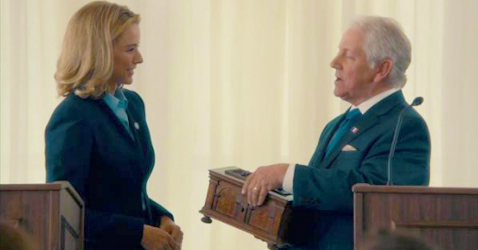
Madame Secretary
Ingrid: That’s what Cheryl and I were talking about…
Cheryl: We did that on Gene Hackman! We had to alter a suit in 10 minutes.
Davis: Other times I’ve come in as a day player… a few times I’ve worked with Ingrid and she knows what I look like, and we’ve had a chance to talk about the character, but then there may be other actors on set who weren’t, for example, entirely honest about their size…
Hahaha!
I’ve also done a lot of background work, both contemporary and period, so you go in on the day and bring a lot of clothes, and the designer or assistant designer signs off on their selection. Sometimes they’ll pull things from stock.
I was in the sequel to Wall Street, and I was so lucky. I went in for a fitting ahead of time because they wanted special looks for all the business people. There happened to be this wonderful suit that fit me so well, and I happened to know some people on the wardrobe crew, so I was able to pull a deal and acquire the suit! But that’s very rare… that doesn’t happen.
Sometimes the clothes don’t fit and they have to run out to get something. But as an actor, you’re usually blissfully unaware of all the stress, or you try to be because you don’t want to make yourself nervous. I try to be accommodating and try to make it work, but it’s best to leave it up to the designers.
If you have actor friends who want to do background work, tell them to get some nice clothes. Because that really helps to bring on set. You can help your actor friends put some clothes together.
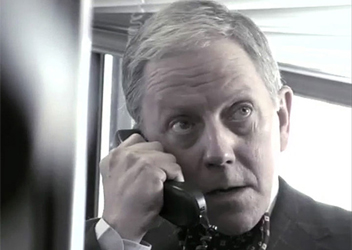
The Agency (2007)
Ingrid: That’s a nice thing to do! You can help your friends put together a few selections, a little wardrobe to have ready. It helps to have the right clothes, doesn’t it?
Cheryl: That helps a lot!
Davis: I did a student film that wound up winning a student academy award. We didn’t have a costume designer. The director said he was getting all this stuff from LA. It turned out we had all this beat up background stuff from Starship Troopers and then there were bits of rags, just rags, so I was put together in a costume with gaffer’s tape and staples, and I thought it would look dreadful, but it worked fine.
Ingrid: It won an Oscar!
Davis: And that guy has gone on to do lots of special effects stuff in LA. He’s a really cool guy. I did another student film which one some awards and the director is about to do a feature…
Ingrid: And he had a designer…
Davis: Yes, and she had a very clear idea of how she wanted the characters to be. And I happened to be a kind of middle class, religious conservative who killed people.
Ingrid: Big twist!
Davis: That’s an interesting little film!
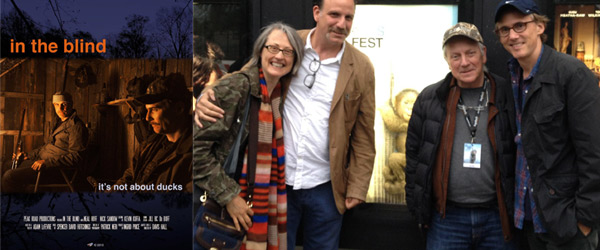
In The Blind- Writer/Director: Davis Hall; Producer: Ingrid Price
Ingrid: So I want to open the room now, if you have questions about working with actors. Some of you have had the opportunity to be in a fitting room with an actor. And we should probably talk about protocol, and what it’s like to have somebody take of their clothes in front of you, because that’s part of the job. Most actors are comfortable dong that … you get a sense during a fitting how relaxed the actor is. It’s a very intimate relationship.
Davis: Even on a big film or show, the changing rooms are not large. There will usually be a curtain or some place to get changed. Or the costumer will ask you to put something on and step out. Usually if I have my briefs on I don’t really much care and I’m certainly ready to change pants and jackets and all of that, because I want to make it easier. And if I see something I like I’ll really speak up and say “boy this looks good, doesn’t it? Don’t you like this?”
Ingrid: When you’re fitting an actor the costume designer or assistant will be in there taking pictures to send to director or the producer, or sometimes even the writer will need to see it. And the actor has the power to make the clothes look great or not…
Davis: They can sell it. That’s one of the things, when a garment really works you can work it. If you’re wearing a suit you can have the tie out and make it look like you’ve been wearing it all day, or you can look really put together. There are certain things you can do… hand in the pocket, give a certain look to help say, “I like this and this will help me play this character.” Sometimes they ask you not to play it too much, they just want to see it without selling it.
Ingrid: Sometimes you can tell by the actor’s body language how they feel about the suit. Jeff Goldblum joined us for a season of Criminal Intent, and I saved all of the fitting photos because Jeff was really very interested in the costumes and he would spend hours with us trying things out and he knew how he wanted to look. So he knew how to sell the costumes he liked in the photos because he knew how he wanted to look and he wanted the producers to like it, so I’ll pass these around.
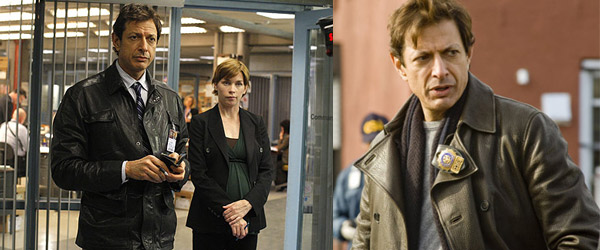
Law & Order: Criminal Intent
Davis: And there are other aspects that come into play, hair and make up are important, but for an actor, wardrobe is probably the most important thing.
Ingrid: Oh say that one more time, it’s music to our ears!
Davis: It is. Wardrobe is the most important thing. Because it visually defines your character more than anything else. We saw a film last night with an amazing Japanese actor, he’s done hundreds of films and plays, he’s 85, he was in films by Kurosawa and he was at the Museum of Moving Image, and somebody asked him if he had any input in what he wears and he said “No, whatever they give me I put it on.”
Ingrid: How about that?
Davis: That’s a guy who’s very secure and works with people who know what will work for him, and he’s been in the business so long and works with people who he trusts. And I thought, boy, I’d love to have that much security.
Ingrid: That’s a lot of confidence. Any questions?
Student: You mentioned about bringing your own clothes for something. Is that normal? Is that mostly extra work?
Davis: It would be mostly for extra work…
Ingrid: Sometimes day players are asked…
Davis: It depends on the character. If it’s a businessman and you have a really nice business suit that you feel comfortable in, it doesn’t hurt to bring it in. If you feel really comfortable in it the costume designer may say, of course. Or we’ll play with ties or shirts. For women it may be more comfortable.
Ingrid: Sometimes I ask if the actor will feel comfortable bringing the outfit they auditioned in. Because that’s part of what got them cast in the role.
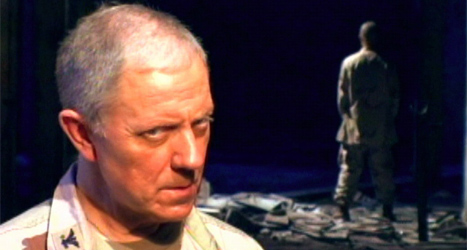
Intelligence (2006)
Davis: Yes, actors talk about that a lot.
Ingrid: Oh, tell them about the rule about callbacks.
Davis: I always wear the same outfit or very similar to a call back.
Ingrid: The costumes become identified with your persona. That’s how powerful costumes are.
Davis: And the auditions are taped so it’s important to look right and dress right because they’re getting a sense of how you look on film. It’s very important to wear something that’s appropriate.
Student: So does your agent tell you what the play or film is about so you can dress accordingly?
Davis: Usually you get a break down that will tell something about the character and how it fits in the story, and you’ve got the dialogue. You used to have to go to the office and pick up your sides… now they just email it to you. And if I have questions I’ll call me agent and see if they know.
Student: I was thinking about doing wardrobe technician stuff in theater and I was thinking it must be nerve wracking not to harm somebody.
Davis: I did a show in college where I was stapled into my costume!
Student: But has a wardrobe person ever hurt you?
Davis: Maybe a pin in the arm has happened, but it’s very, very rare.
Cheryl: I did Fried Green Tomatoes with Cicely Tyson and she had done some research, and her character had been a slave, and she wanted to have a hand crocheted loop, like you put around a button on a fine dress, in her ear. And I said wait, you want me to stick a needle in your ear and hand crochet a loop for an earring? And she said yes. I was terrified! I knew how to hand crochet because when my mother taught me how to sew, she taught me how to do that. I had a needle, so I sterilized it with just a match, and I stuck it in her ear and I did this about twice a week because it would disintegrate. And I said, “you are one brave woman letting me do this,” and she said, “this is what I want and your doing it and it works great. “ But I was very nervous. She’d stand perfectly still and I did that for the whole movie.
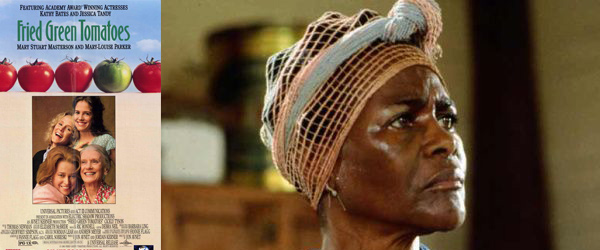
Fried Green Tomatoes (1991)
Cheryl: But I have a question! I’ve worked with two kinds of designers. One just puts a bunch of stuff in a room and says let the actor pick what they want, and the other has ideas and likes to bounce them off of an actor. So have you had those kinds of designers and which would you prefer?
Davis: I think I’d rather have the dialogue. I know of situations like that and there are famous stories of movies where racks of clothes are brought in and whoever gets to the best ones first wins.
Ingrid did a piece for TV and did something like that, and the actor picked the one outfit she wasn’t sure of.
Ingrid: I learned my lesson.
Davis: I like the collaborative aspect of design. I like the fact that the designer has some ideas. I may disagree with them like the rooster costume, which annoyed the hell out of me, and I couldn’t do anything about that. But sometimes a dialogue can emerge and it’s great. I was in a play and I played a French chef. So a chef outfit is pretty direct, but I decided I’d always have half a cigarette hanging out of my mouth. So I had a box of half cigarettes on hand, and that came out of a discussion with the designer about being French and bringing details.
Ingrid: Davis, before you leave us you have to tell us about the time when you were in a play and the action was downstage, and you realized the audience was focused on you even though you were doing nothing.
Davis: Well, the stage manager was focused on me! I was wearing a sort of leisure suit, all cotton, and I was smoking on stage and I lit a cigarette and put the lighter in my pocket, and I’m standing upstage center and the action is happening below, this was at the Kennedy Center. I look into the wings I see the stage manager is gesturing to me, and then I smell something. And I look down and notice my pocket is on fire. So I sort of strolled offstage and took off the jacket, and the stage manager and his assistant stomped on it, and I strolled back onstage without the jacket. And a friend who was in the audience said they never even saw it, because the action was somewhere else and I guess I kept my cool. I remember doing summer stock with bats flying around, but if you keep your cool and you just say, “ok there are bats” it won’t be a problem.
Ingrid: So the lesson is that you have to literally be prepared to stop a fire!
Student: As an actor you have to be a smoker, then?
Davis: I’m not really a smoker, but these were herbal cigarettes. But I can fake it good enough. I can inhale and it’s ok.
Student: When you’re doing a fitting do you typically put everything on at one time?
Davis: It’ll be up to the designer. If it’s like a suit, the pants may come first, or the jacket. It depends on what they think is most important, if it’s really got to fit. So usually we see if the pants fit, now we’ll see it with the tie, now with the jacket.
Ingrid: Or there might be multiple looks where you’ll use an element from one outfit, like maybe we’ll use those jeans again with a different jacket. It’s a very fluid process.
Davis: And sometimes you can say, “Hey can we try that tie? Or that shirt looks awfully nice.” And they say sure. And sometimes you show up on set and it’s totally different.

Ingrid: Sometimes the designer makes their selection of what they think is best and brings the pictures to he director and the director says, “no, I imagined a purple tie!” So… then a purple tie shows up!
Well thanks so much to our guests. We learned so much tonight!